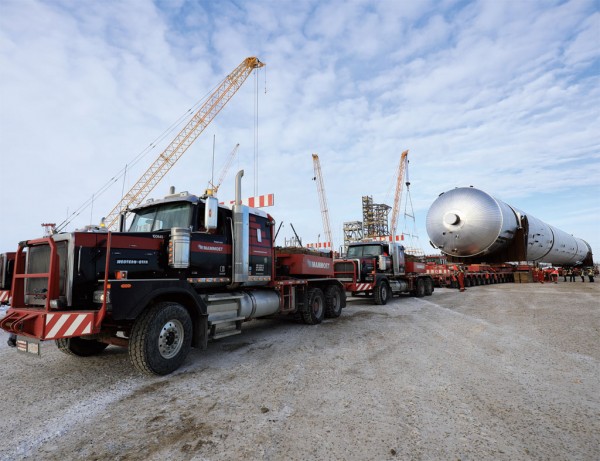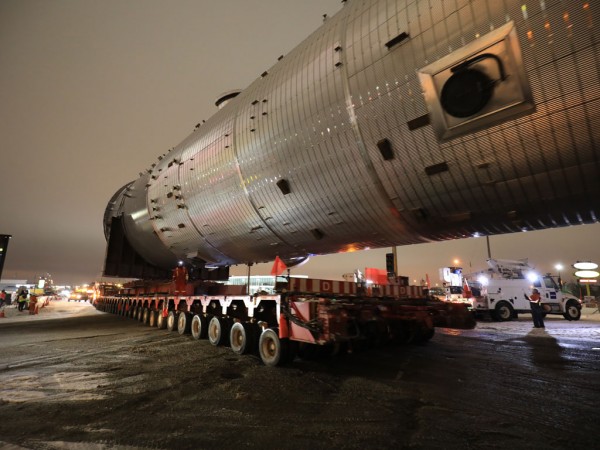Inter Pipeline’s Alberta petrochemical project boasts heaviest road movement in the history of the western Canadian province.
Quite a few “firsts” were attributed to a unique transportation move that took three days on a highway network in Alberta in early January. The heaviest load in history on the western Canadian province’s roads. A petrochemical project described by Inter Pipeline as the first of its kind in Canada. And Mammoet’s qualification of the complex move (without incident) it managed of the giant splitter tower as unprecedented on the Canadian scene.
“Here in Canada, this was our biggest over-the-road transport, and ranks very high on our overall (world) road transport,” Mammoet spokesperson Samantha Schmidt told the American Journal of Transportation. “We have moved modules with SPMTs (self-propelled modular transporters) that were 900 tons, but that was on site. Our biggest move was an 18,000-ton offshore production platform using SPMT to load onto a ship.”

The splitter, roughly the length of a football field and weighing 820 tons, was hauled from its Dacro Industries fabrication yard in Edmonton to its destination, the Heartland Petrochemical Complex under construction near Fort Saskatchewan.
The journey began on Jan. 6 and ended on schedule on Jan. 9. As the huge convoy moved through the region, drivers stopped their cars to witness the historic passage.
School children also looked in awe. “We saw children in the windows of schools watching this go by – it was actually phenomenal,” said Bernard Perron, senior vice-president of Inter Pipeline’s project and operation services. “I think we were all amazed as to mesmerized the entire province was and we got incredible feedback and support.”
This strong response included the high political presence of Alberta Premier Rachel Notley at the petrochemical facility during a special ceremony on Jan. 10.
To make the move happen, Mammoet’s transport crew used six trucks combined for pushing and pulling and two double 26-line intercombi trailers.
SPMT modules can be connected side-by-side or head-to-tail to form large ‘platforms on wheels.’ They allow the possibility of 360 degree steering of wheels, important for getting around tight corners. Their deck height also can be hydraulically adjusted to permit vertical lifting or lowering of the load.

Construction of the complex creating some 13,000 jobs is now underway with completion slated for late 2021. It is located in Strathcona County, not far from Inter Pipeline’s existing Redwater Olefinic Fractionator.
Accompanied by guide vehicles and safety personnel, the convoy moved below the speed limits and made frequent stops. The convoy had the width of two-lane highway and occasionally travelled against the flow of traffic.
The City of Edmonton spent more than 12 months working with the provincial government in planning the route as well as how weight would be distributed across the transport vehicles. The final set-up included added trailers and tires to mitigate any risks of damage to the roads.
In a related development coinciding with the big move, the Alberta government identified needed upgrades to provincial roads and highways for large transportation loads. The network is known as Alberta’s high load corridor. With infrastructure upgrades, the roads could accommodate loads of up to 40 feet tall.
A study found various ways to improve the corridor – notably through bridge strengthening, pavement widening and creating staging and rest areas. The study recommends C$1.6 billion in enhancements that would expand the corridor by 2,100 miles.

Follow us on social media: